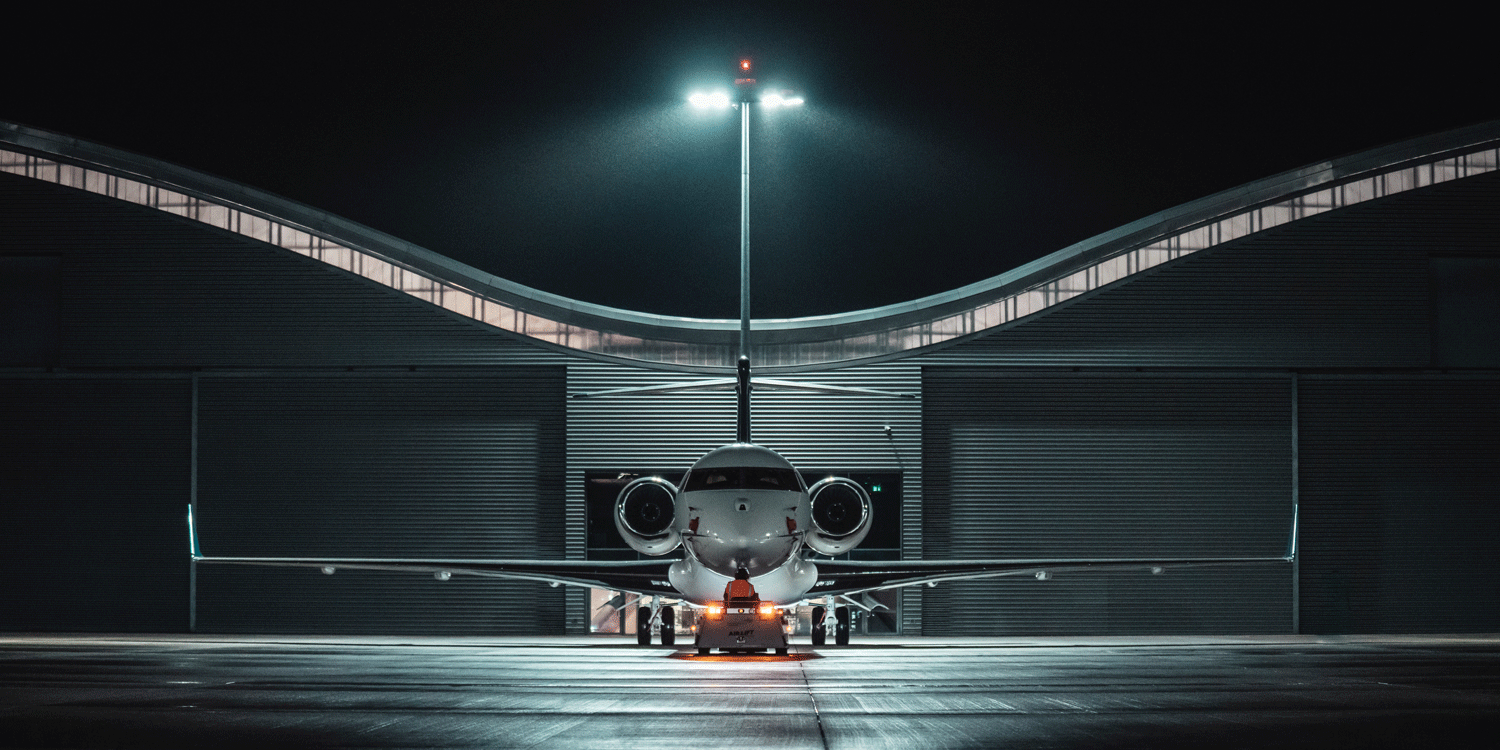Click Here to View This Page on Production Frontend
Click Here to Export Node Content
Click Here to View Printer-Friendly Version (Raw Backend)
Note: front-end display has links to styled print versions.
Content Node ID: 413648
For decades, Farnborough Airport (Booth A37) was universally recognized as the birthplace of British aviation—Samuel Cody flew the first powered aircraft from the site in 1908, for example—and as the location for the eponymous, biennial international air show.
Today, the facility, located 55 kilometers (35 miles) southwest of London, is globally regarded as the leading dedicated business aviation airport in the UK and one of the world’s preeminent gateways for executive aircraft. It has topped the ranking in AIN’s annual survey for best FBO outside the Americas for more than a decade.
Farnborough Airport’s destiny as a leading VIP hub was realized by previous owner TAG Aviation. The Swiss business aviation services provider took over the airport’s leasehold in 2003 and set about transforming the former military airfield into an impressive commercial venture. TAG acquired the freehold to the site from the UK Ministry of Defence in 2007.
The company’s multimillion-dollar investment in the facility has included renovating and expanding the main airport terminal building; erecting several hangars for maintenance, repair, and overhaul (MRO) and aircraft storage; extending the runway to accommodate VIP airliners; expanding taxiways; and installing an instrument landing system and air traffic control tower. TAG also built a five-star hotel on the perimeter of the airport called the Aviator, which since opening in 2008 has proved popular with visiting business aircraft crews.
The airport’s appeal among VIP travelers was immediate. Farnborough recorded 16,449 movements in its first full year of commercial operation in 2003, climbing year-on-year to hit 28,399 takeoffs and landings in 2007. Movements fluctuated over the following decade before climbing to 30,731 in 2018 and 32,366 in 2019, when it was sold to Australian company Macquarie Infrastructure and Real Assets.
“We acquired the airport a few months before the Covid pandemic struck,” said Simon Geere, chief executive of Farnborough Airport. “While movements fell below the 2019 peak in 2020 [19,952] and 2021 [26,000], we benefited hugely from the post-Covid bounce, which saw travelers turn to business aviation in large numbers, and many for the first time.”

This resulted in an all-time movement record at Farnborough in 2022 of 33,120, representing nearly a third of business aircraft traffic at London-area airports, noted Geere. Luton came in second with 27 percent, followed by Biggin Hill with 22 percent, Stansted with 10 percent, Northolt with 7 percent, and London City Airport with 4 percent.
Geere suggests that the pandemic has altered the nature of business aircraft travel with hybrid, flexible, and remote work changing travel patterns and behaviors and disrupting the traditional weekday/weekend patterns of travel.
“Back in 2009 when the planning application was submitted [to Rushmore Borough Council], weekend movements were set at 8,900—around 18 percent of our annual ceiling of 50,000 takeoffs and landings,” said Geere.
Since Covid, air traffic demand has been proportionately similar across all seven days, with weekends and public holidays now representing nearly 30 percent of the airport’s annual traffic. “If this pattern continues, our weekend allocation could be swallowed up,” he explained.
While eager to stress that no plans exist to raise Farnborough’s annual 50,000-movement ceiling, Geere suggested that some flexibility may be required to accommodate the new traffic spread. “Thankfully, the airport is well within its noise base budget contour,” he insisted. “So, we need to have a conversation with the borough council and the local community about reviewing the planning constraint to best support the airport going forward.”
This must be addressed, he argued, if Farnborough is to support its aspirations and maintain its position as the number-one business aviation hub in the UK. The situation could be hastened by the resurgence of commercial airline travel, as large regional hubs such as Luton and Stansted begin to prioritize airline traffic—a consistent and lucrative revenue stream for them—over ad hoc business aircraft flights.
“Farnborough is an essential part of the nation’s airport and aviation infrastructure, so it is vital that we help to free up capacity at the major airports and support the growth of UK business aviation and the economy,” said Geere.
Farnborough Airport has attracted a large line of leading aviation companies to the site, including Dassault, FlightSafety International, Gama Aviation, Flexjet, VistaJet, and Gulfstream. The latter company opened its 225,000-sq-ft European service center there in 2020.
“We serve an array of customers from global corporations and foreign governments to entrepreneurs and medical services providers, and have a based fleet of 63 business aircraft,” said Geere.
“Our customers use business aviation as it is a convenient, flexible, time-sensitive, and secure mode of transport,” he noted. “Farnborough is already the number-one business aviation destination in the UK, so our goal is to be a world leader in this area, setting the standards for premium air travel connectivity, top-class facilities, and exceptional customer care.”
Farnborough Airport broke ground in mid-2022 on a 175,000-sq-ft hanger complex, branded Domus III, which is scheduled to open early next year, joining the site’s already considerable 240,000-sq-ft of hangar space. The apron will also be expanded following the demand for extra aircraft parking. There are two additional pieces of land available on the north and the south of the airfield, Geere noted, which could house extra maintenance capacity. “We've certainly got the space to encourage more MROs to come to Farnborough,” he said.

Sustainability is also a key component of the airport’s strategy, with a pledge to be net-zero “for those emissions we control” by 2030 or sooner. “We are putting sustainability at the heart of everything,” said Geere.
“Our role serving business aviation is one thing, but our role in society is equally important,” he added. “We want to be a catalyst for change going forward.”
Driving demand for sustainable aviation fuel (SAF) at the airport is a significant part of Farnborough’s green strategy. Last year, the airport launched a three-week initiative offering a 38 percent SAF blend for the same price as jet-A1. Geere noted that the scheme didn’t “move the dial a great deal” in terms of the total fuel dispensed in 2022, but it raised awareness among customers and operators.
“It will take time for the industry to fully embrace SAF—and there are logistical, price, and supply issues today—but maybe as a responsible airport, part of our long-term strategy should be limiting our fuel [offering] to SAF,” said Geere.
Farnborough Airport is also “positively changing its brand and values” to be more consumer-driven, he added. “We want to be an aspirational travel brand that people want to be associated with.” To help achieve this goal, Farnborough has introduced a rolling program of brand partnerships at the airport with iconic, highly desirable names that can showcase their brands and products at prime locations throughout the site.
Yachting brokerage Edmiston is the inaugural brand partner. It signed an 18-month deal last year to display its luxury branding at key airport landmarks—notably, the radar tower and entrance—and at various “touchpoints” throughout the passenger’s journey, including the redesigned departure lounge.
Iconic British car manufacturer Aston Martin entered a four-week partnership with Farnborough Airport to showcase its latest luxury vehicle, the DBX707 SUV, to high-end passengers traversing the facility.
“We would also like to bring the likes of Cartier, Rolex, and Bentley to the airport as part of their national campaigns,” said Geere. “They will want to be associated with Farnborough Airport, we will want to be associated with them, and we can start to raise the profile within our consumer markets.”